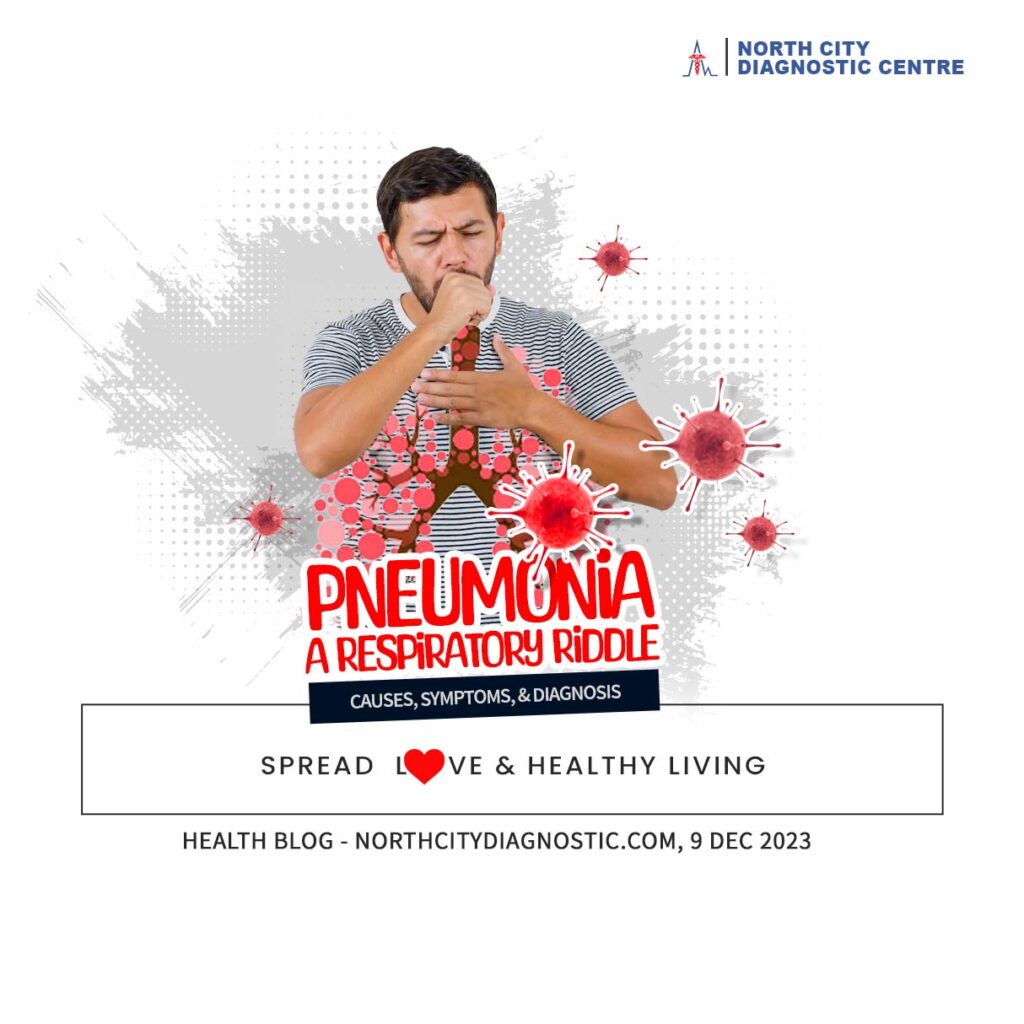
Menu
Pneumonia – a respiratory riddle that affects millions globally. It is often underestimated, is more than a mere infection; it’s a complex interplay of pathogens and predispositions.
Pneumonia results in swollen lung tissue (inflammation) and can result in fluid or pus in the lungs. Bacterial pneumonia is typically more serious than viral pneumonia, which normally recovers on its own.
One or both lungs might be affected by pneumonia. Bilateral or double pneumonia refers to pneumonia that affects both of your lungs.
The severity of pneumonia can range from minor to life-threatening. It is especially dangerous for newborns and young children, persons over the age of 65, and those who have health issues or compromised immune systems.
But fear not! This isn’t a doom-and-gloom narrative. Instead, it’s a beacon of awareness, guiding you through the labyrinth of respiratory health. From understanding the intricacies of pneumonia to identifying its telltale signs, we’re here to empower you with knowledge – the ultimate weapon in your arsenal against respiratory woes.

“Just by taking small precautions against pneumonia, we can save many lives.”
– Sambad English Bureau
Pneumonia is a bacterial, viral, or fungal illness. It causes inflammation in one or both lungs’ air sacs. These sacs, known as alveoli, swell with fluid or pus, making breathing difficult.
Pneumonia, both viral and bacterial, is infectious. This means that they can be passed from person to person via inhalation of airborne droplets from a sneeze or cough.
These kinds of pneumonia can also be contracted by coming into touch with surfaces or items contaminated with pneumonia-causing bacteria or viruses.
Bacterial Pneumonia is caused by bacteria such as Streptococcus pneumoniae or Haemophilus influenzae. Mycoplasma pneumoniae bacteria causes a typical pneumonia, which usually has milder symptoms. Other bacteria that cause CAP (Community-acquired pneumonia) include Haemophilus influenza, Chlamydia pneumoniae and Legionella
SARS-CoV-2 and the influenza virus are the most common cause of viral pneumonia in adults. Respiratory syncytial virus (RSV) is the most common cause of viral pneumonia in young children.
The third type, Fungal pneumonia can be contracted from the environment. It does not transmit from one individual to the next.
Fungal pneumonia are pathogens are, Histoplasma capsulatum, Coccidioides immitis, Blastomyces dermatitidis, Paracoccidioides brasiliensis.
There are also opportunistic fungal pneumonia pathogens like, Candida spp., Aspergillus spp. causing aspergillosis, Mucor spp., Zygomycetes and Cryptococcus neoformans.
Rarely, protozoa like Toxoplasma cause pneumonia. It occurs almost exclusively in persons whose immune systems are compromised.
There are other classifications of Pneumonia as well:
This type of bacterial pneumonia is acquired during a hospital stay. It can be more serious than other types, as the bacteria involved may be more resistant to antibiotics.
This refers to pneumonia that’s acquired outside of a medical or institutional setting.
When people who are using a ventilator get pneumonia, it’s called VAP.
Inhaling bacteria into your lungs from food, drink, or saliva can cause aspiration pneumonia. It’s more likely to occur if you have a swallowing problem, or if you’re too sedated from the use of medications, alcohol, or other drugs.
It is a less severe kind of pneumonia. Walking pneumonia patients may be unaware that they have the disease. Their symptoms may resemble a simple respiratory illness rather than pneumonia. Walking pneumonia may necessitate a lengthier healing period.
Walking pneumonia symptoms might include the following:
Walking pneumonia, on the other hand, is most usually caused by the bacterium Mycoplasma pneumoniae.
Pneumonia symptoms can range from not-so-bad to really serious. Here’s what you might experience:
Now, these symptoms can be different based on your age and health:
Infants: They might not show many signs, but they could vomit, lack energy, or struggle with eating.
Children under 5: They might breathe fast or wheeze.
Older adults: Their symptoms might not be as strong, but they could feel confused or have a lower body temperature.
If you notice these signs, it’s essential to get checked by a doctor.
If you’re dealing with:
It’s time to see your doctor. This is crucial, especially for folks in these high-risk categories:
For older adults and people with heart or lung problems, pneumonia can turn serious pretty quickly. Don’t wait – get to the doctor if you see these signs. Your health is the top priority.
When you visit the doctor you will be asked about when your symptoms started and your overall health.The doctor will then listen to your lungs with a stethoscope for any unusual sounds, like crackling.
Tests, if needed:
This helps spot inflammation in your chest, showing where and how much.
Confirms if there’s an infection and helps identify what’s causing it.
They collect mucus after a deep cough to find the infection’s cause.
Measures the oxygen in your blood, showing how well your lungs are working.
A camera on a flexible tube checks your lung airways, usually if symptoms are severe or you’re not responding well to antibiotics.
A CT scan of your chest is done to get a closer look at your lungs. This helps find pneumonia that might not show up clearly on a regular X-ray. The CT scan is like a super-detailed picture, showing not just your lungs but also the airway (trachea and bronchi). It’s useful for figuring out if there’s an issue in the airway causing pneumonia.
It can also reveal complications of pneumonia, such as abscesses, pleural effusions (fluid around the lungs), and enlarged lymph nodes. It’s like a more advanced way of checking what’s going on inside.
If the doctor suspects there’s fluid around your lungs, they might also take a sample to figure out what’s causing the infection. This helps them get a clearer picture of what’s happening and how to best treat it.
If the doctor thinks there might be fluid around your lungs, they could use an ultrasound. This is like a special kind of test that helps figure out how much fluid is there and why it’s happening. It’s a way for them to get a clear look and better understand what’s going on inside your body.
Usually, doctors don’t use MRI to check for pneumonia. Instead, they might use it to look at the heart, vessels in the chest, and structures in the chest wall. If something’s off in your lungs—like too much fluid, an infection, or a tumor—an MRI can give more details about what’s causing it and how much it’s affecting you.
If your doctor wants to figure out what’s causing your pneumonia, they might ask for a lung biopsy. This means taking small samples from your lungs and checking them out. They can do this using x-ray, CT, ultrasound, or MRI to guide the procedure and get a closer look at what’s going on inside your lungs.
These tests help the doctor figure out what’s going on and how best to help you.
Yes, you can! Here’s how:
Remember, these steps work together to build a shield against pneumonia. It’s not just one thing – it’s a mix of healthy habits that can help keep you well. If you have concerns or questions, feel free to call us at 
At North City Diagnostic Center we offer personalized testing schedule that aligns with your medical history and risk factors. Consistent monitoring can be invaluable for early detection and effective management of arthritis. It’s not just about how often you test but making sure that the tests are aligned with your overall health profile for maximum benefit.
#PneumoniaAwareness #PneumoniaGuide #BreatheBetter #RespiratoryWellness #MedicalInsights #HealthBlog#HealthandWellness #HealthJourney #HealthFirst #NorthCity #HealthBlog #NDC #NorthCityDiagnostic #DiagnosticServices #HealthKnowledge
35-A ,Canal West Road
Near Gouri Bari Bus Stop
Kolkata – 700004.
Local: +91 33 6605 0888